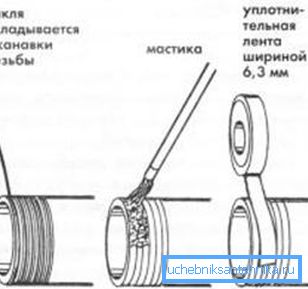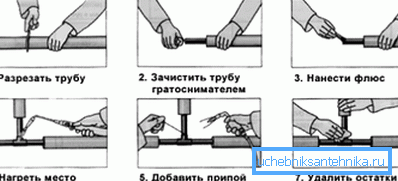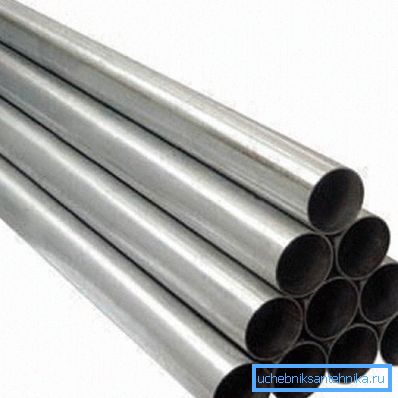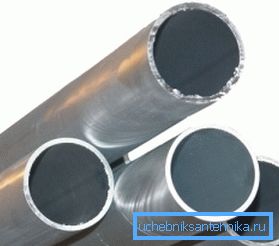What is a galvanized pipe for water and heating
When we use steel pipes for the supply of water, we understand that the main “enemy” of the durability of such products is their corrosion. Many methods have been invented to combat it, but today we will consider products whose surface is covered with a small layer of zinc.

A bit of theory
As a result, the corrosion resistance of the pipeline extends its use by an average of 5-8 years (see also the article Pipe installation in the bathroom: how to do it).
It can be used in a wide range of jobs, for example:
- in construction;
- when cold and hot water is supplied through the plumbing system;
- for heating and gas lines in residential buildings.
Any galvanized metal pipes used in heating and water supply are made from stainless steel. Their length varies in the range of 4-12 m. They differ in an acceptable cost and long service life.

Galvanizing method
There are two methods for processing steel pipes:
| Diffusion |
|
| Hot | A steel pipe is immersed directly in molten zinc at T? 450? C. |

In addition to partial anti-corrosion treatment, it is possible to preserve the original appearance of the product. The surface can be matte or glossy.
Compound
For this pipe for plumbing and heating:
- Mounted on the thread, using a fluoroplastic tape or other materials, such as tow.
Tip: do not use sealing gaskets, because the ends of the parts to be joined are not even when cut with a hacksaw or a disk.
The fittings used in the joints should also be galvanized, in particular, couplings and corners. So you can extend the life of the water supply by 15-25 years.

- Welded to each other with self-protecting wire O 0.8–1.2 mm. Rarely used electrodes up to 3 mm in diameter with rutile or fluorite-calcium coating.
Tip: the instruction does not recommend the use of ordinary electrodes in the work, as this will begin to evaporate the protective zinc layer that affects the welder's health. Because of this, rust also begins to form in these places, negating all efforts.

Classification
Experts distinguish several types that differ among themselves in:
- Kinds - water gas, electrowelded, profile.
- Conditional passage - 10-150 mm.
- The diameter is 17-114 mm.
- Wall thickness - normal, light or reinforced.
- Mark used in the production of steel.

Product Specifications
- Industrial enterprises offer consumers galvanized steel pipes for plumbing and heating systems of varying accuracy, in particular, ordinary and high. For the first use of steel, corresponding to GOST 380 or 1050. Most often they are used for plumbing systems.
- The walls are divided into reinforced, ordinary and light. Regulates this GOST 3262 75 for steel water and gas galvanized pipes. For the production of such products using steel grade St3. Galvanization takes place at the factory using special technology.

Typically, the wall thickness depends on the diameter of the pipe. For example, if the product has an internal diameter of 25 mm and a wall thickness of 4 mm, it can be classified as reinforced. At the same time, for O100 mm, such a thickness will make it possible to attribute the tube to the category of light.
Tip: when there are no special requirements for plumbing, for example, it is required to keep an elevated pressure of the working medium or its mass should be strictly controlled, then choose ordinary pipes.
Because reinforcements will be quite heavy, higher in cost and more difficult to warm up when cooking with gas. In addition, it will be difficult for you to find a familiar tool for cutting threads on them, due to the increased external size.
Light pipe versions with thin walls were originally developed for gas lines, where welded joints are used.

- Products are made with cutting ends and removing burrs or without facing and removing, which correspond to steel water and gas galvanized pipes. Such products come to customers already in a heat-treated condition.
- Their length is measured or multiple measured, the allowance for each cut is up to 5 mm, with deviations no more than 10 mm. They can also produce unmeasured length. However, this is done under an agreement with the customer, when production of not more than 5% of products is allowed, 1.5-4 meters long.
Conclusion
From the article it became clear that galvanized pipes are very resistant to corrosion and practical for use in everyday life. Their low price makes the products cost-effective to use when laying the heating and water supply (see also the article Polypropylene reinforced pipe: the main types and installation technology).
The video in this article will help you find additional information on this topic.